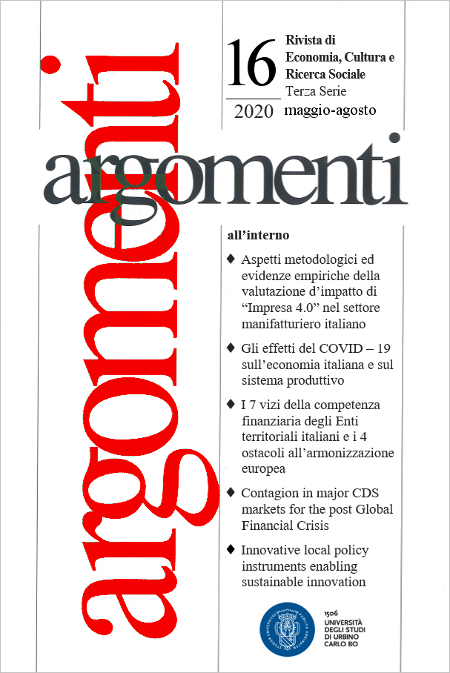Abstract
In order to tackle climate change related threats, international policy leaders developed an agenda for sustainable development and try to boost the dissemination of eco-innovations. This work investigates how innovative policy instruments and approaches enabling innovation for sustainable development are successfully implemented at the local level. Results show that the main enabler is strong collaboration among the different stakeholders. Other enabling factors are the presence of initial and ongoing training, the development of an advertising campaign and the government’s commitment and open approach towards innovative sustainable practices.
Keywords: Eco-innovation, Sustainable development, Policy instrument
Riferimenti bibliografici
Antonioli, D., Borghesi, S., & Mazzanti, M. (2016). Are regional systems greening the economy? Local spillovers, green innovations and firms’ economic performances. Economics of Innovation and New Technology, 25(7), 692–713. https://doi.org/10.1080/10438599.2015.1127557
C40 Cities. (2018). Cities 100: Tshwane - Small scale farming reaps big community benefits. Retrieved from https://www.c40.org/case_studies/cities100-tshwane-small-scale-farming-reaps-big-community-benefits
Circular Ecology. (2018). Sustainability and sustainable development guide. Retrieved March 6, 2018, from http://www.circularecology.com/sustainability-and-sustainable-development.html#.Wp53I7uWwdU
Dallara, A., & Rizzi, P. (2012). Geographic Map of Sustainability in Italian Local Systems. Regional Studies, 46(3), 321–337. https://doi.org/10.1080/00343404.2010.504703
Dimmer, K. (2016). Back to the land. Earthworks, (32).
EEA. (2012). Environmental indicator report 2012: Ecosystem resilience and resource efficiency in a green economy in Europe.
European Commission. (2010). Europe 2020: A strategy for smart, sustainable and inclusive growth. Communication from the Commission. Publications Office of the European Union.
European Commission. (2011). Innovation for a sustainable future- The Eco-Innovation Action Plan (Eco-Ap). Communication from the Commission to the European Parliament, the Council, the European Economic and Social Committee and the Committee of the Regions. Retrieved from https://eur-lex.europa.eu/legal-content/EN/TXT/PDF/?uri=CELEX:52011DC0899&from=EN
European Commission. (2017). European Global Transition Network on Eco-Innovation, Green Economy and Sustainable Development. Retrieved from https://cordis.europa.eu/project/rcn/193867_it.html
European Commission. (2018a). Europe 2020 strategy. Retrieved from https://ec.europa.eu/info/business-economy-euro/economic-and-fiscal-policy-coordination/eu-economic-governance-monitoring-prevention-correction/european-semester/framework/europe-2020-strategy_en
European Commission. (2018b). The Eco-innovation action plan. Retrieved from https://ec.europa.eu/environment/ecoap/about-action-plan/objectives-methodology
European Commission, & European Environment Agency. (2018). About- Climate ADAPT. Retrieved from https://climate-adapt.eea.europa.eu/about
Geissdoerfer, M., Savaget, P., Bocken, N. M. P., & Hultink, E. J. (2017). The Circular Economy – A new sustainability paradigm? Journal of Cleaner Production, 143, 757–768. https://doi.org/10.1016/J.JCLEPRO.2016.12.048
Glcn (Global Lead City Network on Sustainable Procurement). (2018). Tshwane. Retrieved from http://glcn-on-sp.org/cities/tshwane/
Global Opportunity Explorer. (2018). About Global Opportunity Explorer. Retrieved from https://goexplorer.org/about/
Horbach, J. (2008). Determinants of environmental innovation-New evidence from German panel data sources. Research Policy, 37(1), 163–173. https://doi.org/10.1016/j.respol.2007.08.006
ICLEI. (2017). Resilient Cities Report 2017 Tracking local progress on the resilience targets of SDG 11, 1–28. Retrieved from https://resilientcities2018.iclei.org/wp-content/uploads/2017/11/RC2017_Report_Online_26102017_Final-compressed.pdf
Inno4sd.net. (2018). Introduction to the Project content : Eco-innovation. Retrieved from http://www.inno4sd.net/sdgs/introduction/introduction-to-the-project-content.kl
Jang, E. K., Park, M. S., Roh, T. W., & Han, K. J. (2015). Policy instruments for eco-innovation in Asian countries. Sustainability (Switzerland), 7(9), 12586–12614. https://doi.org/10.3390/su70912586
Kanda, W., Hjelm, O., & Bienkowska, D. (2014). Boosting eco-innovation : The role of public support organizations. XXV ISPIM Conference on Innovation for Sustainable Economy and Society, (June). Retrieved from http://www.diva-portal.org/smash/record.jsf?pid=diva2%3A725365&pid=diva2%3A725365&dswid=1163
Legambiente. (2010). Think Globally, Act Locally. Retrieved from https://www.legambiente.it/contenuti/articoli/think-globally-act-locally
Malmborg, F. Von. (2007). Stimulating learning and innovation in networks for regional sustainable development : the role of local authorities, 15, 1730–1741. https://doi.org/10.1016/j.jclepro.2006.08.014
OECD. (2011). Better policies to support Eco-innovation. OECD Studies on Environmental Innovation.
OECD. (2018). The Eco-Mileage System. Observatory of Public Sector Innovation. Retrieved from https://www.oecd.org/governance/observatory-public-sector-innovation/innovations/page/theeco-mileagesystem.htm#tab_lessons
Oltra, V. (2008). Environmental innovations: indicators, stylised facts and sectoral analyses. DIME Working Papers on Environmental Innovation, 7(7), 1–31.
Pertiwiningrum, A., Budyanto, E. C., Hidayat, M., Rochijan, Soeherman, Y., & Habibi, M. F. (2017). Making organic fertilizer using sludge from biogas production as carrier agent of Trichoderma harzianum. Journal of Biological Sciences, 17(1), 21–27. https://doi.org/10.3923/jbs.2017.21.27
Quiroga, C. (2015). How “Green” is Buenos Aires’ Ecological Agenda?, TheBubble. Retrieved from http://www.thebubble.com/green-buenos-aires-ecological-agenda/
Research Italy. (2018). Horizon 2020. Retrieved from https://www.researchitaly.it/en/horizon-2020/
Rogge, K. S., & Reichardt, K. (2016). Policy mixes for sustainability transitions: An extended concept and framework for analysis. Research Policy, 45(8), 1620–1635. https://doi.org/10.1016/j.respol.2016.04.004
Scholl, G., Rubik, F., Kalimo, H., Biedenkopf, K., & Söebech, Ó. (2010). Policies to promote sustainable consumption : Innovative approaches in Europe, 34, 39–50.
Seoul Solution. (2018). Eco-Mileage System. Retrieved from https://www.seoulsolution.kr/en/content/eco-mileage-system-1
Sustainia. (2018). About Sustainia. Retrieved from https://thesustainian.com/about-sustainia/
Tapia, C., & Menger, P. (2015). Stocktaking Session: Identification of Policy Needs with Respect to the Implementation of Ecoinnovation Policies at the Regional and Local Levels. A Particular focus on the MENA Region and the Water- Food-Energy Nexus. WP5: Integration and operationalizat. European Global Transitional Network on Eco-Innovation, Green Economy and Sustainable Development (Green.Eu).
Tecnalia. (2018). Tecnalia Corporation. Retrieved from https://www.tecnalia.com/en/tecnalia/tecnalia-corporation/tecnalia-corporation.htm
The Ellen MacArthur Foundation. (2015). Delivering the circular economy: A toolkit for policymakers. Retrieved from http://www.ellenmacarthurfoundation.org/books-and-reports
The Transformative Actions Program (TAP). (2018a). Food and Energy Agropolitan City. Retrieved from http://tap-potential.org/projects/food-and-energy-agropolitan-city/
The Transformative Actions Program (TAP). (2018b). What is the tap? Retrieved from http://tap-potential.org/about-tap/
Tshwane Economic Development Agency. (2014). Tshwane story. Retrieved from http://www.teda.org.za/tshwane-story/#fb0=74
UN-Habitat. (2011). The Best Practices Database. Retrieved from http://mirror.unhabitat.org/content.asp?typeid=19&catid=34&cid=10256
UN-Habitat. (2018). Local Governments. Retrieved from http://mirror.unhabitat.org/content.asp?cid=380&catid=365&typeid=24&subMenuId=0
United Nations. (2015). Transforming our world: the 2030 Agenda for Sustainable Development. General Assembley 70 Session, 16301(October), 1–35. https://doi.org/10.1007/s13398-014-0173-7.2
United Nations. (2018). Sustainable Development Goals. Retrieved from http://www.un.org/sustainabledevelopment/sustainable-development-goals/
Vancouver Economic Commission. (2015). Towards the Circular Economy: Identifying local and regional government policies for developing a circular economy in the fashion and textiles sector in Vancouver, Canada, (September), 98. https://doi.org/10.1162/108819806775545321
VVSG. (2016). Glocal. Localising the sustainable development goals. Lokaal. Retrieved from http://www.vvsg.be/Internationaal/Documents/2016Lokaal05_Katern EN_0305.pdf
You, N., & Kitio, V. (2005). Overview of the Best Practices Knowledge Management Framework. United Nations Department of Economic and Social Affairs, 1–8.
WCED. (1987). Our Common Future. Oxford University Press.
L'opera è pubblicata sotto Licenza Creative Commons - 4.0 International (CC BY 4.0)





